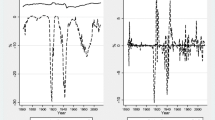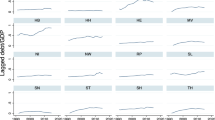Abstract
In this paper, we define deficit sustainability by requiring formally that both the discounted debt vanish asymptotically and the undiscounted debt be bounded. Thus, a new necessary condition and a new testing procedure emerge. We propose a new test statistic and prove that its limiting distribution is standard normal, N(0, 1). Its finite- sample distribution differs from N(0, 1), however, mainly because it has fat tails, so we derive empirical critical values using simulations. Using the new test and United States (US) quarterly data, the conclusions of three earlier papers that fail to reject the sustainability of the US budget or current-account deficit are reversed.
Similar content being viewed by others
References
Bohn H (2007) Are stationarity and cointegration restrictions really necessary for intertemporal budget constraint?. J Monet Econ 54: 1837–1847
Box GEP, Jenkins GM (1976) Time series analysis: forecasting and control. Holden Day, Oakland, CA
Cuddington JT (1997) Analyzing the sustainability of fiscal deficits in developing countries. The World Bank, International Finance Division, Policy Research Working Paper 1784
Dickey DA, Fuller WA (1981) Likelihood ratio statistics for autoregressive time-series with a unit root. Econometrica 49: 1057–72
Engle RF, Granger CWJ (1987) Cointegration and error correction: representation, estimation, and testing. Econometrica 55: 251–276
Gregory AW, Hansen BE (1996) Residual-based tests for cointegration in models with regime shifts. J Econom 70: 99–126
Gregory AW, Hansen BE (1996) Tests for cointegration in models with regime and trend shifts. Oxford B Econ Stat 58: 555–560
Hakkio CS, Rush M (1991) Is the budget deficit “too large?”. Econ Inq 29: 429–445
Hamilton JD (1994) Time series analysis. Princeton University Press, Princeton
Haug AA (1995) Has federal budget deficit policy changed in recent years?. Econ Inq 33: 104–118
Hayashi F (2000) Econometrics. Princeton University Press, Princeton
Holmes MJ (2006) How sustainable are OECD current account balances in the long-run?. Manch Sch 74: 626–643
Husted S (1992) The emerging U.S. current account deficit in the 1980s: a cointegration analysis. Rev Econ Stat 74: 159–166
Kwiatkowski D, Phillips PCB, Schmidt P, Shin Y (1992) Testing the null hypothesis of stationarity against the alternative of a unit root: how sure are we that economic time series have a unit root?. J Econom 54: 159–178
Lee J, Strazicich MC (2003) Minimum Lagrange multiplier unit root test with two structural breaks. Rev Econ Stat 85: 1082–1089
Lee J, Strazicich MC (2004) Minimum LM unit root test with one structural break. Unpublished manuscript
MacKinnon JG (1991) Critical values for cointegration tests. In: Engle RF, Granger CWJ (eds) Long-run economic relationships: readings in cointegration. Oxford University Press, Oxford, pp 267–276
Martin GM (2000) US deficit sustainability: a new approach based on multiple endogenous breaks. J Appl Econom 15: 83–105
McCallum BT (1984) Are bond-financed deficits inflationary? a Ricardian analysis. J Polit Econ 92: 123–135
Ng S, Perron P (2001) Lag length selection and the construction of the unit root tests with good size and power. Econometrica 69: 1519–1554
Payne JE (1997) International evidence on the sustainability of budget deficits. Appl Econ Lett 4: 775–779
Pesaran MH, Shin Y, Smith RJ (2001) Bounds testing approaches to the analysis of level relationships. J Appl Econom 16: 289–326
Quintos CE (1995) Sustainability of the deficit process with structural shifts. J Bus Econ Stat 13: 409–417
Sargent TJ, Wallace N (1981) Some unpleasant monetarist arithmetic. Fed Reserv Bank Minneap Q Rev 5(Fall): 1–17
Tanner E, Liu P (1994) Is the budget deficit “too large”?: some further evidence. Econ Inq 32: 511–518
Trehan B, Walsh CE (1991) Testing intertemporal budget constraints: theory and applications to U.S. Federal Budget and current account deficits. J Money Credit Bank 23: 206–223
Wilcox DW (1989) The sustainability of government deficits: implications of the present-value borrowing constraint. J Money Credit Bank 21: 291–306
Wu J-L, Chen S-L, Lee H-Y (2001) Are current account deficits sustainable? Evidence from panel cointegration. Econ Lett 72: 219–224
Wu J-L, Fountas S, Chen S-L (1996) Testing for the sustainability of the current account deficit in two industrial countries. Econ Lett 52: 193–198
Xiao Z, Phillips PCB (1998) Higher-order approximations for frequency domain time series regression. J Econom 86: 297–336
Author information
Authors and Affiliations
Corresponding author
Rights and permissions
About this article
Cite this article
Hatzinikolaou, D., Simos, T. A new test for deficit sustainability and its application to US data. Empir Econ 45, 61–79 (2013). https://doi.org/10.1007/s00181-012-0607-z
Received:
Accepted:
Published:
Issue Date:
DOI: https://doi.org/10.1007/s00181-012-0607-z




